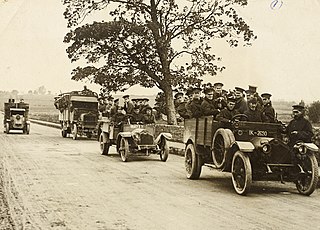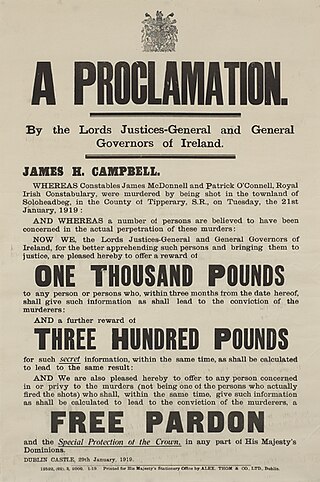Related Research Articles

The Black and Tans were constables recruited into the Royal Irish Constabulary (RIC) as reinforcements during the Irish War of Independence. Recruitment began in Great Britain in January 1920, and about 10,000 men enlisted during the conflict. The majority were unemployed former British soldiers from England who had fought in the First World War. Some sources count Irish recruits to the RIC from 1920 as 'Black and Tans'.

The Easter Rising, also known as the Easter Rebellion, was an armed insurrection in Ireland during Easter Week in April 1916. The Rising was launched by Irish republicans against British rule in Ireland with the aim of establishing an independent Irish Republic while the United Kingdom was fighting the First World War. It was the most significant uprising in Ireland since the rebellion of 1798 and the first armed conflict of the Irish revolutionary period. Sixteen of the Rising's leaders were executed starting in May 1916. The nature of the executions, and subsequent political developments, ultimately contributed to an increase in popular support for Irish independence.

The Irish War of Independence or Anglo-Irish War was a guerrilla war fought in Ireland from 1919 to 1921 between the Irish Republican Army and British forces: the British Army, along with the quasi-military Royal Irish Constabulary (RIC) and its paramilitary forces the Auxiliaries and Ulster Special Constabulary (USC). It was part of the Irish revolutionary period.

The Royal Irish Constabulary was the police force in Ireland from 1822 until 1922, when all of the island was part of the United Kingdom. A separate civic police force, the unarmed Dublin Metropolitan Police (DMP), patrolled the capital and parts of County Wicklow, while the cities of Derry and Belfast, originally with their own police forces, later had special divisions within the RIC. For most of its history, the ethnic and religious makeup of the RIC broadly matched that of the Irish population, although Anglo-Irish Protestants were overrepresented among its senior officers.

The Irish Volunteers, also known as the Irish Volunteer Force or the Irish Volunteer Army, was a paramilitary organisation established in 1913 by nationalists and republicans in Ireland. It was ostensibly formed in response to the formation of its Irish unionist/loyalist counterpart the Ulster Volunteers in 1912, and its declared primary aim was "to secure and maintain the rights and liberties common to the whole people of Ireland". Its ranks included members of the Conradh na Gaeilge, Ancient Order of Hibernians, Sinn Féin and the Irish Republican Brotherhood. Increasing rapidly to a strength of nearly 200,000 by mid-1914, it split in September of that year over John Redmond's support for the British war effort during World War I, with the smaller group opposed to Redmond's decision retaining the name "Irish Volunteers".

Thomas Patrick Ashe was a member of the Gaelic League, the Gaelic Athletic Association, the Irish Republican Brotherhood (IRB) and a founding member of the Irish Volunteers.

Oranmore is a town in County Galway, Ireland, 9 km (5.6 mi) east of Galway city on an inlet of Galway Bay. At the 2022 census, Oranmore had a population of 5,819.

William Joseph Mellows was an Irish republican and Sinn Féin politician. Born in England to an English father and Irish mother, he grew up in Ashton-under-Lyne before moving to Ireland, being raised in Cork, Dublin and his mother's native Wexford. He was active with the Irish Republican Brotherhood and Irish Volunteers, and participated in the Easter Rising in County Galway and the War of Independence. Elected as a TD to the First Dáil, he rejected the Anglo-Irish Treaty. During the Irish Civil War Mellows was captured by Pro-Treaty forces after the surrender of the Four Courts in June 1922. On 8 December 1922 he was one of four senior IRA men executed by the Provisional Government.

This is a timeline of the Irish War of Independence of 1919–21. The Irish War of Independence was a guerrilla conflict and most of the fighting was conducted on a small scale by the standards of conventional warfare.
Richard "Dick" McKee was a prominent member of the Irish Republican Army (IRA). He was also friend to some senior members in the republican movement, including Éamon de Valera, Austin Stack and Michael Collins. Along with Peadar Clancy and Conor Clune, he was killed by his captors in Dublin Castle on Sunday, 21 November 1920, a day known as Bloody Sunday that also saw the killing of a network of British intelligence agents by the "Squad" unit of the Irish Republican Army and the killing of 14 people in Croke Park by the Royal Irish Constabulary (RIC).

Broadstone railway station was the Dublin terminus of the Midland Great Western Railway (MGWR), located in the Dublin suburb of Broadstone. The site also contained the MGWR railway works and a steam locomotive motive power depot. A Luas tram station opened at the front of the station in 2017.
Tomás Bairéad (1893–1973) was an Irish author and nationalist. Born in Galway, his father was called Michael Barrett and his mother Mary McDonough. He had two sisters and one brother. He was a member of the Moycullen group of the Irish Volunteers in 1916 and soon after became an IRA volunteer. He was also a member of the Irish Republican Brotherhood (IRB) and Sinn Féin. He was part of a group of Volunteers who were involved in the burning of the RIC Barracks in Rosmuc in 1920. He began his journalistic career with the Galway Express, a weekly republican paper. In 1922 he joined the Irish Independent, writing on politics, and would later become the newspaper's editor in 1945. While working for the Independent he was presented the Irish Academy of Letters Award (1938). Bairéad also invented his own Irish shorthand. His close friend, Máirtín Ó Cadhain, urged him to leave the IRA to focus on his writings.

The 3rd Tipperary Brigade was one of the most active of approximately 80 such units that constituted the IRA during the Irish War of Independence. The brigade was based in southern Tipperary and conducted its activities mainly in mid-Munster.

Patrick Henry Pearse was an Irish teacher, barrister, poet, writer, nationalist, republican political activist and revolutionary who was one of the leaders of the Easter Rising in 1916. Following his execution along with fifteen others, Pearse came to be seen by many as the embodiment of the rebellion.
Pádraig Ó Fathaigh (1879–1976) was a member of the Gaelic League and an Intelligence Officer of the Irish Republican Army.
Larry Lardner, a native of Athenry, County Galway, was a Brigade Commandant for the Irish Republican Army in his locality. He was by trade a publican and a member of the Irish Republican Brotherhood (IRB) Supreme Council for Connacht in 1917. He, along with Liam Mellows and Pádraig Ó Fathaigh, travelled to Limerick where they were informed by Patrick Pearse at an IRB meeting that a rebellion would take place at Easter 1916.
The Rineen ambush was an ambush carried out by the Mid Clare Brigade of the Irish Republican Army (IRA) on 22 September 1920, during the Irish War of Independence. The attack took place at Drummin Hill in the townland of Drummin, near the hamlet of Rineen, County Clare.
Tom Ruane was captain of the Second Western Division of the Irish Republican Army from 1916 to 1920.

The Soloheadbeg ambush took place on 21 January 1919, when members of the Irish Volunteers ambushed Royal Irish Constabulary (RIC) officers who were escorting a consignment of gelignite explosives at Soloheadbeg, County Tipperary. Two RIC officers were killed and their weapons and the explosives were stolen. The Volunteers acted on their own initiative and had not sought authorisation for their action. As it happened on the same day that the revolutionary Irish parliament first met and declared Ireland's independence, it is often seen as the first engagement of the Irish War of Independence.

The Battle of Ashbourne took place, near Ashbourne, County Meath, during the Easter Rising in Ireland in 1916. The Rising, also known as the Easter Rebellion, was an armed insurrection in Ireland during Easter Week in April 1916. The Rising was launched by Irish republicans against British rule in Ireland with the aim of establishing an independent Irish Republic. It was the first armed conflict of the Irish revolutionary period. The Battle of Ashbourne would be the only significant conflict to occur outside Dublin.
References
- ↑ Land and Revolution: Nationalist Politics in the West of Ireland 1891-1921, Fergus Campbell, Oxford University Press, 2005; ISBN 0-19-927324-3 page 210.
- ↑ Galway City Council - Heritage Magazine - Summer 2006 - Page 27 Archived 20 November 2007 at the Wayback Machine Archived 2007-11-20 at the Wayback Machine
- ↑ Hoare, Pádraig (7 March 2018). "Businesses urged to engage with Revenue after storm". Irish Examiner. Retrieved 23 June 2020.
- ↑ The History of Galway, by Sean Spellissy, ISBN 0-9534683-3-X, Celtic Bookshop, (1999), page 131.
- ↑ Pádraig Ó Fathaigh's War of Independence: Recollections of a Galway Gaelic Leaguer, Timothy G. McMahon, Cork University Press, 2000; ISBN 1-85918-145-7
- ↑ Howley Statue Picture
- ↑ IrishWarMemorials.ie - Howley Memorial - Oranmore